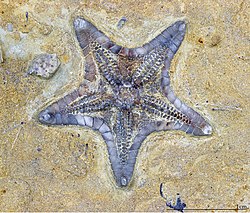This article relies largely or entirely on a single source .(November 2022) |
| Marocaster Temporal range: | |
|---|---|
 | |
| Marocaster coronatus – Holotype- Muséum de Toulouse | |
| Scientific classification | |
| Kingdom: | Animalia |
| Phylum: | Echinodermata |
| Class: | Asteroidea |
| Order: | Valvatida |
| Family: | Goniasteridae |
| Genus: | † Marocaster Blake & Reboul, 2011 |
| Species: | †M. coronatus |
| Binomial name | |
| †Marocaster coronatus Blake & Reboul, 2011 | |
Marocaster is an extinct genus of sea stars in the family Goniasteridae. It existed in what is now Morocco during the early Cretaceous period. It was described by Daniel B. Blake and Roland Reboul in 2011, and the type species (and only species) is Marocaster coronatus. [1]